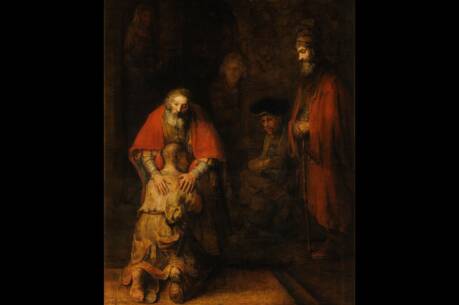God loves all of creation. We should too.
Today is the first Sunday of Lent, the 40-day period in which we prepare ourselves mentally and physically for Easter, focusing on prayer, fasting, almsgiving and service to others. Today’s readings invite us to reflect on God’s loving relationship with all of creation.
‘I am establishing my covenant with you and your descendants and with every living creature.’ (Gn 9:9-10)
What can you do to care for creation?
Do today’s readings inspire you to change how you live?
How do you hope to grow and change during Lent?
In the first reading, we hear about the covenant that God makes with all living creatures, human and nonhuman animals together. This is called the Noahic covenant, as Noah is the central partner. In the context of the biblical narrative, the earth and nearly all of its inhabitants had been destroyed by flood. The destructive flood waters metaphorically wash away the corruption and sin of the earth, a cleansing the second reading interprets as similar to being washed in the waters of baptism. After the flood, the divine relationship with living creatures is affirmed using the legal language of covenant to express God’s commitment to creation’s survival. The special interest in both human and nonhuman animal life is at the heart of the Noahic covenant and is remembered by the rainbow in the clouds. The beginning of Lent is an excellent time to reflect on the implications of this passage. God’s love for creation is re-established in this covenant and should influence us to show love and care for all of creation.
The Gospel, too, highlights God’s connection with creation, although it can be overlooked because there are several important elements in today’s Gospel. Fittingly for the first Sunday of Lent, we hear of Jesus’ 40 days of testing in the wilderness. Mark does not describe the nature of the temptations, which are expanded upon in the Gospels of Matthew and Luke. The duration of Jesus’ wilderness experience becomes a model for the 40-day period of Lent, as the number is significant throughout biblical tradition as a time of prayer, testing and often transformation.
Mark describes Jesus being tempted by Satan, waited on by angels and among wild beasts. While obvious, it could be missed that each of these characters is not human. The New Testament scholar Richard Bauckham suggests that Jesus enters the wilderness in order to encounter beings of the nonhuman world in order to establish a relationship there before preaching to the human world. In his encounter with Satan, Jesus establishes his authority and ability to overcome temptations he might face beyond the wilderness. Jesus’ relationship with angels is verified as positive and productive, as they offer him support. Jesus’ living in the company of wild animals may signal that he has established a harmonious relationship with all creatures, even those often considered dangerous. Bauckham notes the importance of this peaceful relationship as an indicator of the messianic age. In the prophet Isaiah, for instance, a future messianic ruler would bring forth a time of peace between human and nonhuman animals (Is 11:6-9). By depicting Jesus with the animals, Mark signals that he has a relationship with all creatures and that he is the awaited messiah.
As we embark on this Lenten journey, today’s readings inspire us to be mindful and attuned to all of creation and the ways that we support or harm our fellow creatures. As creator, God shows love and affection for all living things, and we should imitate God in that regard. As Pope Francis reminds us, “All of us can cooperate as instruments of God for the care of creation” (“Laudato Si’,” No. 14).
This article also appeared in print, under the headline “God’s Creation,” in the February 2021, issue.









